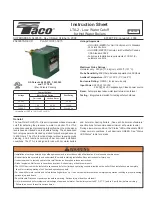
11
isar + programmer -
Installation and Servicing
GENERAL
4
SYSTEM REQUIREMENTS - CH (continued) and Hot Water
an additional vessel MUST be installed on the return
to the boiler.
Guidance on vessel sizing is given in Frame 3.
5. Filling.
The system may be filled by the following method:
a.
Through a temporary hose connection from a 'draw-off'
tap, supplied from a service pipe under mains pressure.
Where the mains pressure is excessive a pressure
reducing valve must be used to facilitate filling.
When installing the filling device it must be connected as
shown below, to fully comply with the water regulations.
This may involve the fitting of an additional WRAS
approved isolator valve to the mains supply.
i.
Thoroughly flush out the whole system with
cold water.
ii.
Fill and vent the system until the pressure
gauge registers 1.5 bar and examine for leaks.
iii.
Check the operation of the safety valve by
raising the water pressure until the valve lifts.
This should occur within 0.3 bar of the preset lift
pressure.
iv.
Release water from the system until the
minimum system design pressure is reached;
1.0 bar if the system is to be pre-pressurised.
Water Flow Rate and Pressure Loss
Max CH Output
kW
23.4
(Btu/h)
(80 000)
Water flow rate
l/sec
0.37
(gal/min)
4.8
Temperature Differential
o
C
15
(
o
F)
(27)
Head available for
m.w.g.
2.3
system pump.
(ft.w.g.)
7.5
DOMESTIC HOT WATER
1.
The domestic hot water service must be in accordance
with BS 5546 and BS 6700.
2.
Refer to Table 1 for minimum and maximum working
pressures.
3.
The boilers are suitable for connection to most types of
washing machine and dishwasher appliances.
4.
When connecting to suitable showers, ensure that:
a.
The cold inlet to the boiler is fitted with an approved
anti-vacuum or syphon non-return valve.
b.
Hot and cold water supplies to the shower are of equal
pressure.
C
H
Return
E
c
l
6
053
H
ose
un
i
ons
M
a
i
ns
water
supp
l
y
T
emporary
hose
(
d
i
sconnect
after
f
illi
ng
)
Add
i
t
i
ona
l
stop
va
l
ve
Doub
l
e
chec
k
va
l
ve
assemb
l
y
(
note direction of flow
)
The boiler does not normally need a bypass but at least some
radiators on the heating circuit, of load of at least 10% of the
minimum boiler output, must be provided with twin lockshield
valves so that this minimum heating load is always available.
See note regarding thermostatic radiator valves on page 10.
Note. Systems
incorporating zone valves which could
completely cut off the flow through the system must also
include a bypass.
BALANCING
1.
Set the programmer to ON.
Close the manual or thermostatic valves on all radiators,
leaving the twin lockshield valves (on the radiators referred
to above) in the OPEN position.
5
SYSTEM BALANCING
Turn up the room thermostat and adjust these lockshield
valves to give boiler flow and return temperatures not
more than 20
o
C apart.
These valves should now be left as set.
2.
Open all manual or thermostatic radiator valves and
adjust the lockshield valves on the remaining radiators,
to give around 15
o
C temperature drop at each radiator.
3.
Adjust the room thermostat and programmer to
NORMAL settings.
5. Hard Water Areas
Where the water hardness exceeds 200mg/litre, it is
recommended that a proprietary scale reducing device is
fitted into the boiler cold supply within the requirements of
the local water company.
IMPORTANT
Provision MUST be made to accommodate the expansion of
DHW contained within the appliance, if a non-return valve is
fitted to the DHW inlet.
202851-1new.pmd
17/11/2006, 07:40
11












































